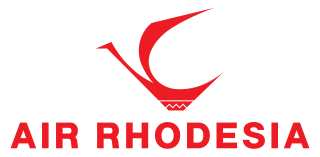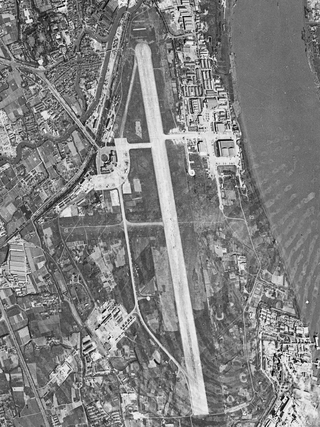
Airborne Express was an express delivery company and cargo airline. Headquartered in Seattle, Washington, its hub was in Wilmington, Ohio. Airborne was founded as the Airborne Flower Traffic Association of California in 1946 to fly flowers from Hawaii to the US mainland. Airborne Express was acquired by DHL in 2003. Prior to the acquisition, it rose to be the third largest private express delivery company in the United States, behind Federal Express and United Parcel Service (UPS).

Indian Airlines was a state-owned airline in India that later became a division of Air India Limited before ultimately ceasing operations. It was based in Delhi and focused primarily on domestic routes, along with several international services to neighbouring countries in Asia and limited flights to the Middle East and Southeast Asia. It was a division of Air India Limited after the merger of eight pre-Independence domestic airlines.

Air Gabon was the national, state-owned airline of Gabon, operating out of Libreville International Airport to a variety of destinations across western and southern Africa, as well as to Europe. Founded in 1951, the airline went bankrupt in 2006.

Air Rhodesia was the national airline of Rhodesia. Its head office was located on the property of Salisbury Airport in Salisbury.

The de Havilland DH.114 Heron is a small propeller-driven British airliner that first flew on 10 May 1950. It was a development of the twin-engine de Havilland Dove, with a stretched fuselage and two more engines. It was designed as a rugged, conventional low-wing monoplane with tricycle undercarriage that could be used on regional and commuter routes. A total of 149 were built; it was also exported to about 30 countries. Herons later formed the basis for various conversions, such as the Riley Turbo Skyliner and the Saunders ST-27 and ST-28.

The Vickers VC.1 Viking is a British twin-engine short-range airliner derived from the Vickers Wellington bomber and built by Vickers-Armstrongs Limited at Brooklands near Weybridge in Surrey. After the Second World War, the Viking was an important airliner with British airlines, pending the development of turboprop aircraft like the Viscount. An experimental airframe was fitted with Rolls-Royce Nene turbojets and first flown in 1948 as the world's first pure jet transport aircraft. Military developments were the Vickers Valetta and the Vickers Varsity.

Cameroon Airlines was an airline from Cameroon, serving as flag carrier of the country. Based in Douala, it operated scheduled services within Africa, as well as to Europe and the Middle East out of its hub at Douala International Airport, with a second network focus on Yaoundé Nsimalen International Airport. The company was 96.43 percent state-owned, with the remaining shares having been held by Air France. It ceased operations in March 2008; its role as Cameroon's flag carrier was taken over by Camair-Co. The company slogan was French: Pour mieux vous servir, To serve you better.
Air Malawi Limited was the state-owned national airline of Malawi, based in Blantyre, which operated regional passenger services. Because of its financial situation, the airline was placed in voluntary liquidation, the Malawi Government announced in November 2012, and flights have been suspended since February 2013.
Air Ontario Inc. was a Canadian regional airline with its predecessor initially headquartered in Sarnia and later in London, Ontario. In 2002, Air Ontario became Air Canada Jazz.

The Beechcraft 1900 is a U.S made twin-engine turboprop regional airliner manufactured by Beechcraft. It is also used as a freight aircraft and corporate transport, and by several governmental and military organizations. With customers favoring larger regional jets, then-owner Raytheon ended production in October 2002.
Compagnie Africaine d'Aviation, renamed FlyCAA in 2013, is a regional airline from the Democratic Republic of the Congo, based at N'djili Airport in Kinshasa. It offers an extensive network of domestic scheduled passenger flights, as well as cargo flights. Due to safety and security concerns, CAA has been included in the list of air carriers banned in the European Union.

Robert Gabriel Mugabe International Airport, and formerly known as Harare International Airport and Salisbury Airport, is an international airport in Harare, Zimbabwe. It is the largest airport in the country and serves as the base of Air Zimbabwe, the national flag carrier. It is operated by the Civil Aviation Authority of Zimbabwe.

Rhodesian Air Services (RAS) was an airline from Southern Rhodesia (today's Zimbabwe, until 1963 part of the Federation of Rhodesia and Nyasaland) from 1960 to 1965. Formed by Jack Malloch and headquartered in Salisbury, it operated scheduled and chartered passenger flights on regional routes.
Houma–Terrebonne Airport is a public airport located three miles (5 km) southeast of the central business district of Houma, a city in Terrebonne Parish, Louisiana, United States. It is owned by the Houma–Terrebonne Airport Commission.

Shanghai Longhua Airport, then called Shanghai Lunghwa Airport, was a converted general aviation airport and PLAAF airfield located south of downtown Shanghai, China, on the bank of the Huangpu River. It opened in the early 1920s and served as the city's airport until the 1950s when Shanghai Hongqiao International Airport opened. Thereafter, it was one of two general aviation airports serving Shanghai and also served as an emergency landing site for police, fire and rescue operations southwest of the city. The airport was eventually closed at 1966, and the airport grounds were slowly built over though a period of between 1993 and 2016.
Hunting-Clan Air Transport was a wholly private, British independent airline that was founded in the immediate post-World War II period. It began trading on 1 January 1946 as Hunting Air Travel Ltd. It was a subsidiary of the Hunting Group of companies, which had come from the shipping industry and could trace its history back to the 19th century. The newly formed airline's first operating base was at Bovingdon Airport in Southeast England. Its main activities were contract, scheduled and non-scheduled domestic and international air services that were initially operated with Douglas Dakota and Vickers Viking piston airliners from the company's Bovingdon base. A change of name to Hunting Air Transport occurred in 1951. By that time, the airline had emerged as one of the healthiest and most securely financed independent airlines in Britain.













